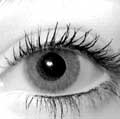 This article from researchers at the University of Notre Dame discusses some of the limitations of iris biometric systems. Pupil dilation, for example, is found to affect the accuracy of iris recognition, especially if the amount of dilation is different at enrollment than at verification. Wearing contact lenses, especially cosmetic lenses designed to change the color and appearance of the eye, can also decrease recognition rates. The researchers also find that the false rejection rate increases over the four-year time span they have tested.
This article from researchers at the University of Notre Dame discusses some of the limitations of iris biometric systems. Pupil dilation, for example, is found to affect the accuracy of iris recognition, especially if the amount of dilation is different at enrollment than at verification. Wearing contact lenses, especially cosmetic lenses designed to change the color and appearance of the eye, can also decrease recognition rates. The researchers also find that the false rejection rate increases over the four-year time span they have tested.
This is important because iris-based systems are often considered the most accurate and stable forms of biometric identification. Clearly, more research into the limitations is needed.
Toward the next generation of iris biometrics science
Many factors complicate the use of iris biometrics, such as differences in pupil dilation, the presence of contact lenses, and the eye’s natural aging.
